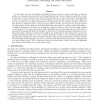Free Online Productivity Tools
i2Speak
i2Symbol
i2OCR
iTex2Img
iWeb2Print
iWeb2Shot
i2Type
iPdf2Split
iPdf2Merge
i2Bopomofo
i2Arabic
i2Style
i2Image
i2PDF
iLatex2Rtf
Sci2ools
APPROX
2006
Springer
2006
Springer
Fractional Matching Via Balls-and-Bins
In this paper we relate the problem of finding structures related to perfect matchings in bipartite graphs to a stochastic process similar to throwing balls into bins. Given a bipartite graph with n nodes on each side, we view each node on the left as having balls that it can throw into nodes on the right (bins) to which it is adjacent. If each node on the left throws exactly one ball and each bin on the right gets exactly one ball, then the edges represented by the ball-placement form a perfect matching. Further, if each thrower is allowed to throw a large but equal number of balls, and each bin on the right receives an equal number of balls, then the set of ball-placements corresponds to a perfect fractional matching
| Added | 20 Aug 2010 |
| Updated | 20 Aug 2010 |
| Type | Conference |
| Year | 2006 |
| Where | APPROX |
| Authors | Rajeev Motwani, Rina Panigrahy, Ying Xu 0002 |
Comments (0)

